Toyota Hilux Review 2024 | heycar
Written by Ivan Aistrop
Quick overview
Pros
- Should be faultlessly reliable
- Very generous warranty package
- Decent to drive by pick-up standards
Cons
- Entry-level version sparsely equipped
- Some rather functional interior plastics
- Ride and refinement not up to passenger car standards
Overall verdict on the Toyota Hilux
"Newer pick-up truck rivals feel more sophisticated but there’s still lots going for the Toyota Hilux, which is competitive with its rivals in pretty much every other area. It may well also dazzle you with its tremendous reliability, dazzling warranty package and off-roading prowess."
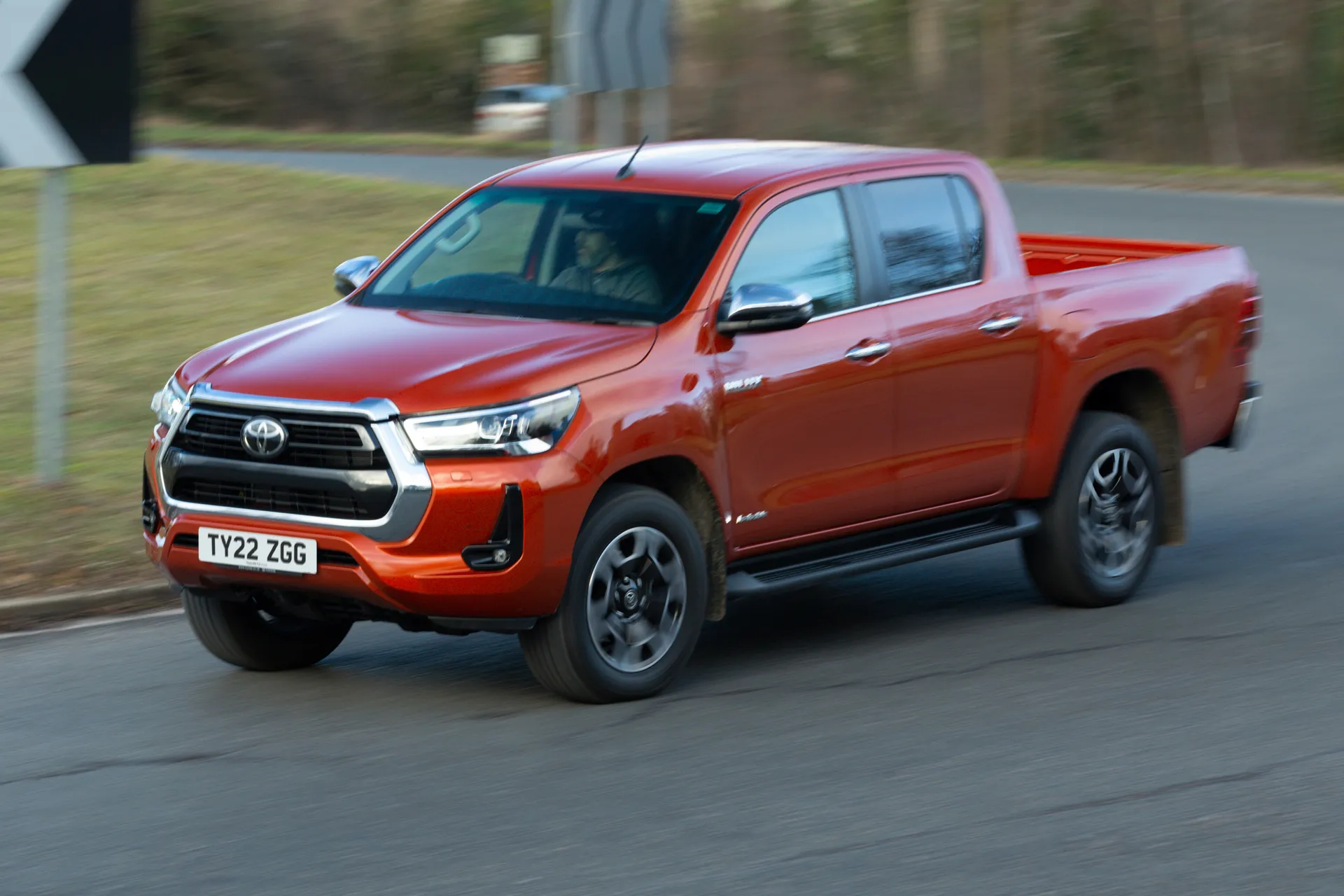
The Toyota Hilux is a vehicle that has transcended its original purpose. It was designed as a no-nonsense workhorse pick-up truck for transporting hay bales around farms or bricks around building sites. And very good it was at those endeavours, too.
These days, however, the Hilux – and pick-up trucks in general – are being used more and more as conventional transport. The best double-cab examples can easily double as family cars, and if you have a family with an active lifestyle and plenty of outdoorsy hobbies, a pick-up can be the perfect foil for your exploits thanks to its vast cargo-carrying capacity and its go-anywhere off-roading ability. What’s more, the way that taxation works in regards to pick-ups means that it can be a very affordable means of running a vehicle that might otherwise be relatively expensive.
The Hilux has existed for several decades, so its various generations have been ever-present in the pick-up-truck sector. Because that sector has condensed significantly in recent years, the Hilux arguably has fewer rivals than ever before. Emissions laws have done for some models, and economic pressures have done for others, but regardless, trucks that were previously popular, such as the Nissan Navara and Mitsubishi L200, are now no more.
It’s also important to recognise that the pick-up market is somewhat polarised in terms of the talents its various offerings bring. At one end of the scale, you have trucks like the Ssangyong Musso and Isuzu D-Max, which take the traditional no-nonsense workhorse route to appeal to the industrious end of the market. At the other end, you have offerings like the latest Ford Ranger and Volkswagen Amarok (a joint development effort between the two manufacturers) that are less hardcore and rather more civilised to appeal to the lifestyle set. The Hilux lies somewhere in the middle, but does that mean it’s a jack of all trades, or a master of none?
Well, there’s no doubting its durability. Sure, the more lifestyle-focused trucks on offer may feel posher inside, but the Hilux feels totally unbreakable in how it's constructed, and Toyota’s unbelievable reputation for reliability (backed up by an incredible warranty) means it probably is.
Otherwise, the Hilux feels competitive with its rivals in pretty much every area. It feels pretty good on the road by pick-up track standards, although those used to an SUV might find it a bit too rough-and-ready with its rather jumpy ride and clattery diesel engines. Provided you avoid the entry-level trim, it’s pretty well stocked with luxury equipment.
Looking for a used car for sale? We've got 100s of Toyota Approved Used Cars for Sale for you to choose from, including a wide range of Toyota Hilux pick-ups for sale.
Is the Toyota Hilux right for you?
If you’re looking for a smart, reliable, dependable and borderline unbreakable workhorse, then yes, it absolutely is. Newer, more sophisticated rivals such as the Ford Ranger and Volkswagen Amarok may be more sophisticated inside and on the road, but the jury is still out on whether these can cut it with more traditional offerings (such as the Hilux) when it comes to being a working vehicle. The big Toyota is a strong all-rounder, and definitely worthy of your consideration.
What’s the best Toyota Hilux model/engine to choose?
There are two engines to choose from, both four-cylinder turbodiesels. The entry-level 150PS 2.4-litre option will be fine if you don’t tend to hurry but you might find life a little more relaxing if you choose the brawnier 2.8-litre engine, with its 204PS. It’s perkier, quieter, and generally more pleasant to live with, not to mention actually being more economical than the smaller unit. For maximum relaxation, pair it with the six-speed automatic gearbox rather than the standard six-speed manual.
Of the trim levels available, we’d steer clear of the basic entry-level Active trim for a variety of reasons (more on those later). The second-rung Icon trim gives some critically important upgrades that’ll make life vastly more palatable for you and your passengers, so that’s the one we’d recommend for the sweet spot of equipment and cost. That said, we wouldn’t blame you for upgrading a step further to Invincible trim if only for the front and rear parking sensors that will come in very handy on a vehicle as vast as this. Invincible X and GR Sport trims look rather expensive, though, and the AT35 Arctic Trucks version will basically just punch you repeatedly in the bank account.
What other pick-ups are similar to the Toyota Hilux?
Due to emissions laws, plus a variety of other political and commercial pressures, a number of rival pick-up truck models have now been withdrawn from sale as brand new vehicles. These include stalwarts such as the Mitsubishi L200, Nissan Navara and Mercedes X-Class. If you’re considering a used Hilux, though, these will still be worth considering alongside the Toyota. Rivals such as the Ssangyong Musso and Isuzu D-Max are still going strong, however, along with the newest competition on the block – the latest versions of the Ford Ranger and Volkswagen Amarok.
Comfort and design: Toyota Hilux interior
"The Hilux’s rather utilitarian interior may not be your cup of tea if you’re used to a family SUV, but if you’re accustomed to pick-up trucks there’s nothing here that’ll make you moan, and a few things you might even be quite impressed with."
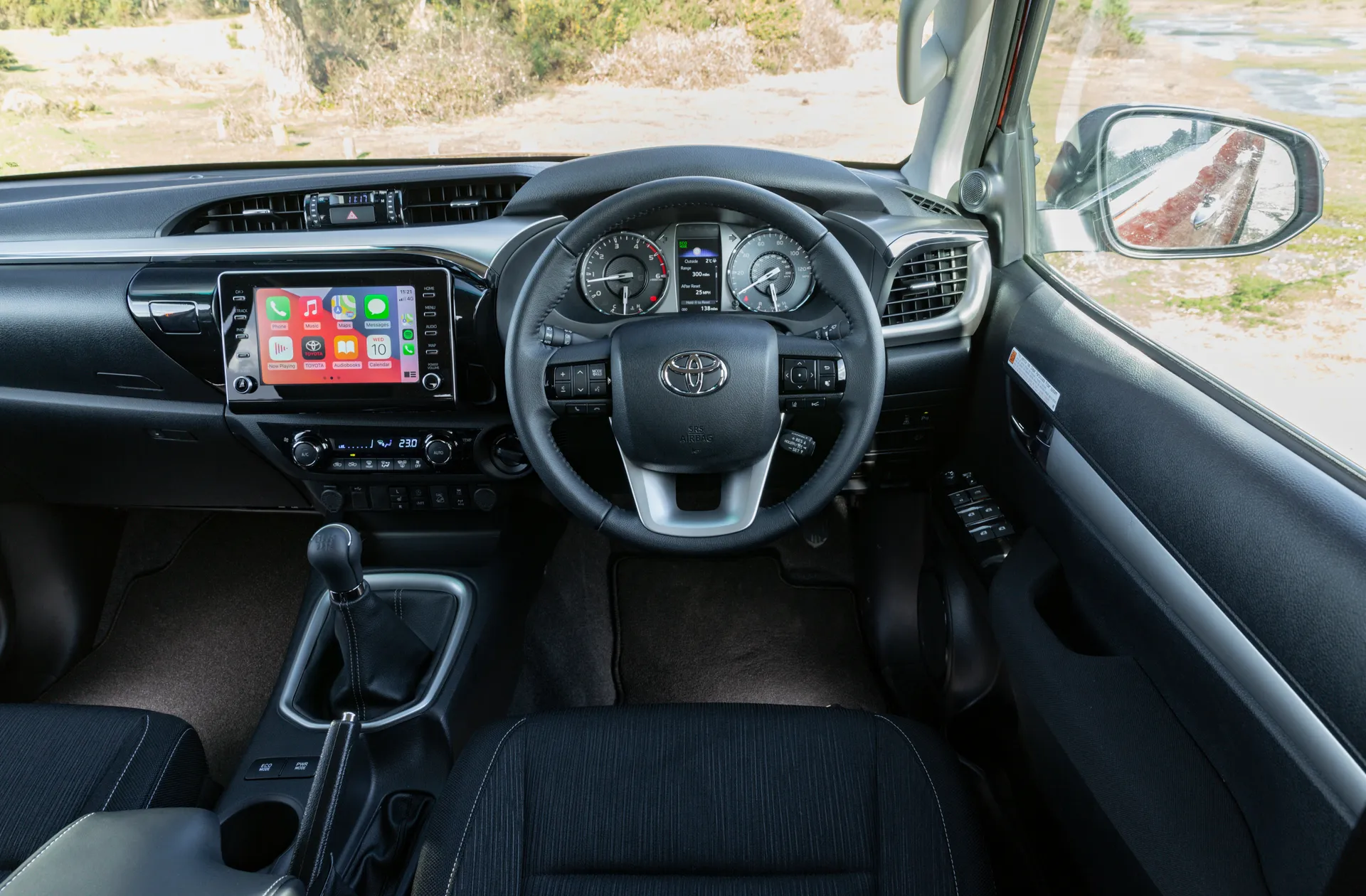
There are a variety of reasons that you might want to avoid the entry-level Active trim but one of them is the comfort of your driving position. This version misses out on a height-adjustable driver's seat, so while all versions get a steering column that adjusts for reach and rake, you may still struggle to find a comfortable driving position. Specify an Invincible X trim version or upwards, meanwhile, and you get powered adjustment for your driver’s seat.
Regardless of trim, you get a lofty driving position – this is a vehicle you have to climb up into rather than plop down into – giving you a great view of the road ahead, aided further by slim windscreen pillars and a bonnet that it’s easy to see the extremities of. You might not be so confident with the rear end, because the small rear window makes it tricky to see where the massive load bay ends. It’s a good job, then, that all versions bar the Active get a reversing camera (yet another reason to swerve the entry-level trim).
Most switches and buttons are placed where you expect to find them, and although the Hilux’s dashboard design could be accused of looking a little dated, that does at least mean you get a set of buttons and rotary dials for controlling the air-con, meaning you don’t have to delve into on-screen menus.
Cabin storage is another impressive area for the Hilux. The centre console has a deep lidded cubby, two cupholders and a number of other small storage nooks, while there are also two big gloveboxes, and ingenious little drawers that slide out of either side of the dashboard, and double as two more cupholders.
Quality and finish
You’d expect a workmanlike vehicle to have an interior that concentrates on durability and robustness rather than plushness and sophistication, and that’s just what the Hilux does. Those used to a family SUV might baulk at the hard-edged, grainy plastics used in much of the big Toyota’s interior, but folk coming from rival pick-ups will be completely unflustered, maybe even a little impressed. Everything has a properly sturdy, built-to-last feel, and versions with the touchscreen, which is all but the entry-level Active trim, even manage to feel a little high-tech.
Infotainment: Touchscreen, USB, nav and stereo in the Toyota Hilux
The entry-level Active trim comes with a very basic stereo system that has AM/FM radio, a CD player (remember those?), a Bluetooth phone connection and four speakers. You do get a USB port for charging devices, though. Then from Icon trim upwards, you get Toyota’s Touch 2 touchscreen multimedia system, which adds two more speakers, DAB radio, and smartphone connectivity via Apple CarPlay and Android Auto. If you want native navigation rather than letting your phone take care of navigation duties (although we can’t see why you would), you’ll need to specify Invincible X trim at least, and if you want a JBL premium audio system with nine speakers, it’s GR Sport trim or nothing.
The touchscreen system isn’t the best one you’ll encounter, unfortunately, with small and fiddly on-screen icons and a screen that could be more responsive.
Space and practicality: Toyota Hilux boot space
The Hilux is available in three body styles. The single cab has two doors and two seats, while the extra cab also has two doors, but has a couple of extra chairs behind the front seats for occasional use. You will only want to use them occasionally, because they’re rather tight on space and the seating position is rather awkward. The double cab is by far the most popular body style, as this gives you four doors and five seats, all of which come with a very decent amount of headroom and legroom. The wide cabin also gives plenty of shoulder room, so those in the back shouldn’t feel like they’re getting too over-familiar with their neighbours. The backrest of the rear seats feels pretty upright, but it’s still a fairly comfortable place to sit regardless.
Luggage space is a bit of an odd one. Obviously the loadbay is huge in all versions – even more so in the single cab and extra cab bodystyles – but if your luggage needs to stay dry, you’ll either have to fit some sort of load cover over the top of the loadbay, such as a retractable rolling cover, or stack your bags up inside the cabin, which will rob you of passenger space.
All Hiluxes have a payload of more than 1,000kg, and all versions can tow a braked trailer of up to 3,500kg, which is about as good as towing weights get.
Handling and ride quality: What is the Toyota Hilux like to drive?
"The Hilux isn’t the most dynamically polished vehicle you’ll ever drive, either in terms of ride comfort or handling ability, but the same can be said about pretty much any pick-up truck rival. It gets far more impressive once you take it off the beaten track, however."
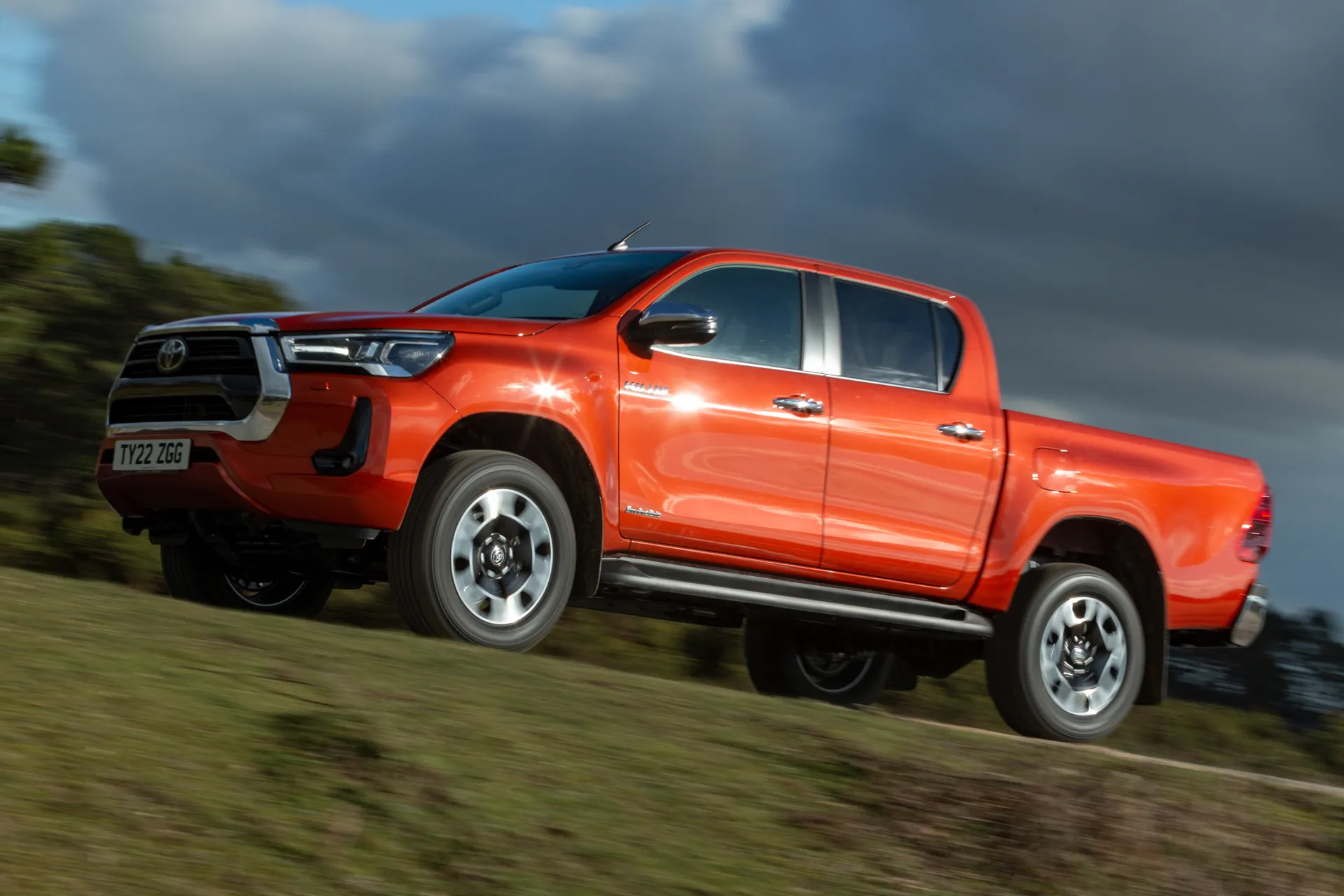
The suspension of a pick-up truck has rather more to cope with than that of a regular car. Like in any vehicle, the suspension has to both absorb the effects of bumps in the road to keep you comfortable, and it has to control the movement of the bodywork as you move along the road. In a pick-up, however, the suspension also has to be able to deal with carrying huge amounts of weight in the loadbed, and that inevitably has an impact on how it performs on the first two tasks.
The rear suspension of the Hilux has to be quite hard, and that makes the ride rather jumpy and unsettled at all speeds. Things improve when you get a bit of weight into the loadbay, because the ride becomes slightly less jittery, but whatever happens, you’ll still be less comfortable than you will be in a regular family SUV. You’ll also be a bit less comfy that you will be in the latest Ford Ranger, although that rival aside, the Hilux is very competitive in the pick-up truck class when it comes to ride comfort.
It’s pretty competitive when it comes to handling, too, although this still isn’t a vehicle you’ll want to drive quickly. The tall body leans over pretty easily, while the steering is rather slow and vague, and the tyres will soon start to protest if your cornering speeds become too optimistic. Again, a Ford Ranger has the edge in this area, but the Hilux does an entirely decent job.
It’s off the beaten track where the Hilux becomes rather more impressive, thanks to the selectable four-wheel drive with high- and low-range gearing, plus various other bits of off-roading trickery including a switchable rear differential lock and various additional electronic systems such as hill-descent control. There are very few places you’ll need to go that a Hilux can’t take you to.
And then there’s the AT35, a Hilux prepared by off-roading firm Arctic Trucks, with heavy duty suspension that’s been jacked up even further, with performance dampers and all sorts of other specialist dynamic hardware. It’s very hardcore, but very expensive.
What engines and gearboxes are available in the Toyota Hilux?
Hilux buyers have the choice of two four-cylinder diesel engines. The first is a 2.4-litre unit with 150PS, while the other is a 2.8-litre engine pushing out 204PS. Both are available with either a six-speed manual gearbox or a six-speed automatic.
Going purely by the spec sheet, you’d say that no version of the Hilux looks especially sprightly. Go for the 2.4 engine and your 0-62mph sprint time will be just over the 13-second mark with the manual gearbox, and just under that threshold with the automatic. The 2.8-litre version is rather brisker, with equivalent 0-62mph sprint times of 10.2 seconds for the manual and 10.7 seconds for the automatic.
In the real world, though, we’re sure performance will be entirely adequate for most. The Hilux we tried was the 2.8 automatic and it felt effortlessly brisk enough to keep life easy. To be honest, when driving a vehicle like the Hilux, you wouldn’t want to go any faster than this engine and gearbox combination takes you anyway.
Refinement and noise levels
This isn’t an area you expect any pick-up truck to excel in, so it’s entirely forgivable that the Hilux does no better than the norm. Large, agricultural machines like these are always going to feel a bit rough-and-ready compared with your average family SUV, and so it proves.
The diesel engine rattles and clatters as the revs rise and fall, and while the engine noise stays reasonably distant just below the legal motorway limit, it becomes rather more pronounced when you’re right on that limit. The automatic gearbox we tried was a little slow to shift sometimes and often liked to hang onto lower revs to draw improved performance from the engine, and that makes life a fraction noisier still.
At most speeds, you can hear the suspension clonking away as it goes about its work, while the chunky tyres kick up a fair bit of road noise at speed and the bluff design of the front end results in some wind noise, too. It’s not the most civilised vehicle you’ll ever drive, then, but that’s entirely forgivable considering the sort of vehicle it is, and it’s no worse than most of its direct rivals.
Safety equipment: How safe is the Toyota Hilux?
We like it when a vehicle gives you the same comprehensive suite of safety kit regardless of which of the various trim levels you pick, and that’s broadly what the Hilux does.
All trims give you the Toyota Safety Sense package of electronic driver aids, including automatic emergency braking, adaptive cruise control, lane-departure warning and road-sign assist, and you also get the usual array of active traction management systems, on top of the standard four-wheel drive.
If the worst does happen, you get seven airbags to help keep you from harm, plus an eCall emergency alert system. The only slight differences in safety spec between versions is that entry-level Active trim misses out on Downhill Assist Control, and only double-cab bodystyles have Isofix child seat mounting points.
When the car was tested by Euro NCAP back in 2016, the Toyota Safety Sense kit was an optional extra, and the Hilux achieved a three-star crash-test rating without the package, and five stars with it. It was subsequently made standard across the range.
MPG and fuel costs: What does a Toyota Hilux cost to run?
"The Hilux is a very big machine, and predictably, fairly thirsty as a result, but it should prove no thirstier than pick-up truck rivals, so it is at least competitive."
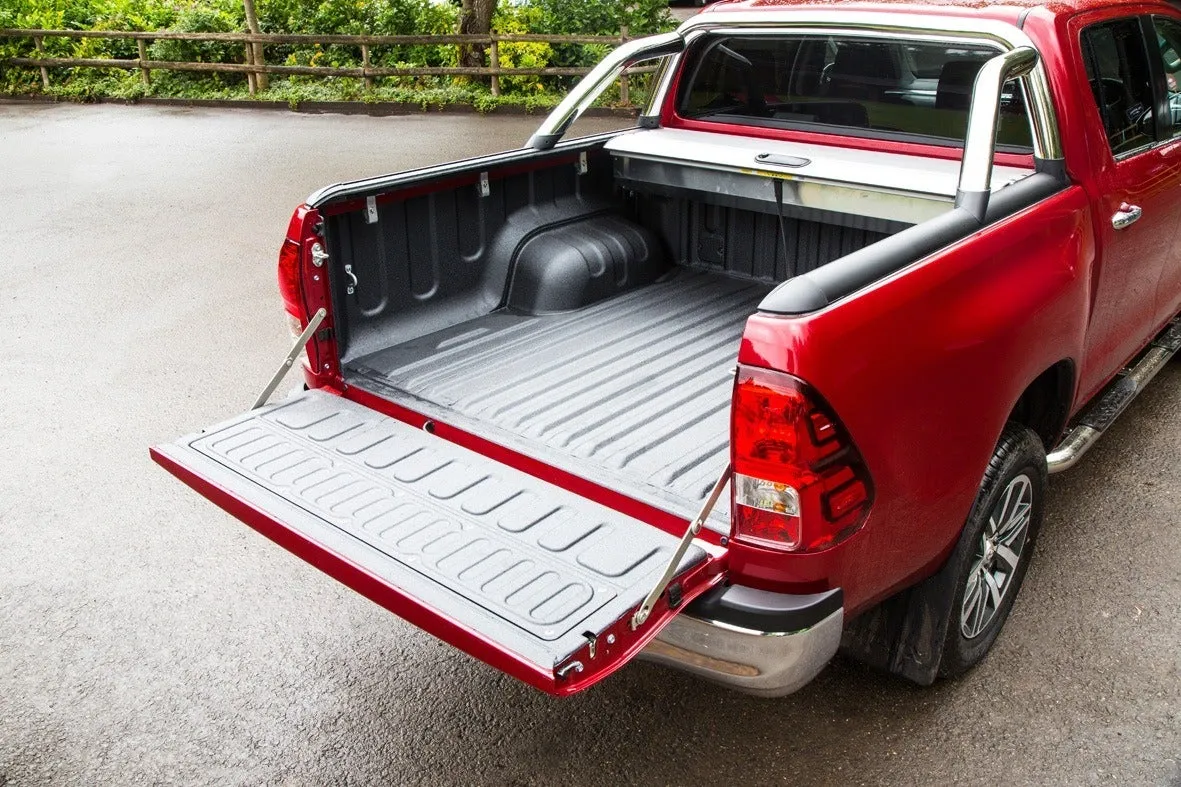
As we’ve observed, the Hilux is only available with diesel power, and although that’s not very fashionable these days, it’s still pretty much the most efficient way to move around an enormous lump of steel like the Hilux.
Both the 2.4 and 2.8 diesels are available with both a six-speed manual gearbox and a six-speed automatic. According to official fuel consumption figures, your choice of transmission makes hardly any difference with the 2.4-litre engine (you’ll get up to 31.7mpg with the manual and 30.1mpg for the auto), while the difference is slightly bigger with the 2.8-litre engine, with figures of 33.2mpg for the manual and 30.1mpg for the auto.
You’ll notice, too, that unconventionally, the bigger, more powerful engine returns better economy than the more modest one. That’ll be because the bigger engine is less strained when going about the business of hauling around the Hilux’s massive body.
Those numbers are competitive compared with those of rivals like the latest Ford Ranger, and importantly, these are numbers you might actually have a chance of seeing in the real world if our testing is anything to go by.
How reliable is the Toyota Hilux?
Happily, the answer to this question is “about as reliable as it gets”. Toyota’s reputation in this area is the envy of the motor industry, and although the brand only finished fourth in the rundown of most reliable manufacturers in the latest HonestJohn.co.uk Satisfaction Index, two of the three brands above it were Lexus and Subaru, which share plenty of mechanicals with Toyota. Look at pretty much any other reliability study going, and Toyota will probably be even closer to the top spot.
The Hilux has gained a reputation for being among the toughest Toyotas going, thanks in part to a vintage Top Gear episode that failed to destroy a Hilux even after burning it out, drowning it in the ocean, and demolishing a building on top of it.
And, like every other Toyota, the Hilux comes with a potentially industry-leading warranty package. The initial agreement is a fairly bog-standard three-year, 60,000-mile arrangement, but have your vehicle serviced according to schedule at a main dealer, and your cover is automatically extended by a year or 10,000 miles, up to a maximum of 10 years or 100,000 miles.
Insurance groups and costs
Go for an Active or an Icon model, and your Hilux will sit in group 41 for insurance. Since group 1 vehicles are the cheapest to insure and group 50 are the most expensive, it shows that no version will give you particularly low premiums. Invincible versions sit in group 42 when fitted with the 2.4-litre engine and 45 when fitted with the 2.8. The group 45 rating also applies to Invincible X versions, but for reasons we can’t quite fathom, the GR Sport version sits slightly lower in group 43. The Invincible X AT35 will be the priciest to insure, sitting in group 49.
VED car tax: What is the annual road tax on a Toyota Hilux?
Tax implications are one of the most compelling reasons to choose a pick-up truck. Provided your truck has a payload of 1,000kg or more – which all Hilux variants do – you pay a flat rate of Vehicle Excise Duty on it no matter how much the list price is or how inefficient it is. That flat rate is £320 per year, and if your truck is a particularly expensive one, that could save you a good few quid in the first few years of its life compared to an equivalent car.
More compelling is the financial argument for company car drivers, who again pay a flat rate of Benefit-in-Kind company car tax, provided that minimum payload figure is met. That rate is £66 per month for a 20% taxpayer or £132 per month at 40%, which is cheap compared with a lot of regular cars, let alone ones this big and inefficient, which will cost you heaps more to run and a company vehicle.
How much should you be paying for a used Toyota Hilux?
"The price you pay for a new Hilux will depend on how you buy, but the used car market can throw up some very decent savings, and you won’t have to wait for the thing to be built and shipped to you."
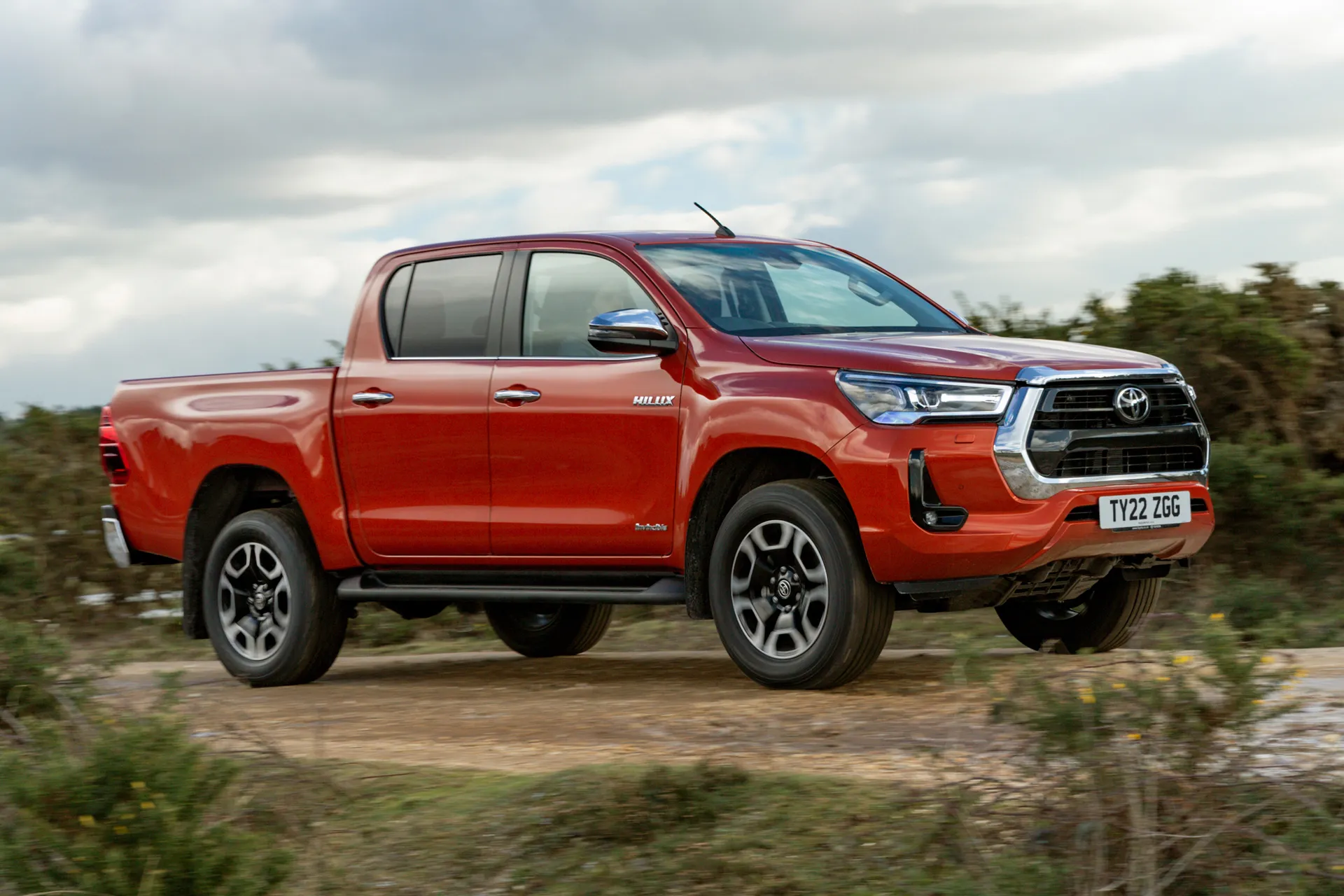
Regular on-the-road prices for regular versions of the Hilux range between approximately £34,000 and £50,000 when buying brand new. For now, we’ll ignore the AT35’s ludicrous price of £73,000, because that version is incredibly niche.
That’s not the full story, though, because if the truck is bought through your business, and certain criteria are met, you can claim back the VAT payable on the vehicle – depending on the spec you choose, you could get back anything between £5,000 and £8,000 from the exchequer.
Browsing the used market can throw up rather bigger savings, though. Our listings feature several examples of three-year-old trucks in appealing specifications with 50,000 miles or less under their wheels, and many of these cost a good £15,000-£20,000 less than what you’d pay for a brand new equivalent.
Trim levels and standard equipment
Entry-level Active trim is the workhorse of the range, but it’s not an entirely no-frills experience. Sure, you have to make do with 17-inch steel wheels and durable fabric upholstery, but you do get remote locking, electrically adjusting door mirrors, manual air-conditioning, powered windows and automatic lights.
Next up are the Icon versions, and these look a good bit smarter with 17-inch alloy wheels and a range of other styling enhancements. You also get a reversing camera, automatic limited slip differential, a height-adjustable driver’s seat, upgraded fabric upholstery, leather steering wheel and gear selector, power-folding door mirrors and LED fog lights, plus those important infotainment grades we mentioned earlier.
Specifying Invincible trim gives you 18-inch alloys, smart entry and start, an auto-dimming rear-view mirror, front and rear parking sensors, windscreen wiper de-icers, automatic air-conditioning, heated front seats and LED headlights and tail lights. Invincible X trim, meanwhile, gets you a 360-degree camera, ambient lighting, heated rear seats, powered driver’s seat adjustment, dual-tone leather upholstery and a few more exterior styling bits. Other than a few darker coloured exterior styling pieces and the upgraded stereo we mentioned earlier, GR Sport doesn’t add a whole lot.
Get our latest advice, news and offers
Keep me updated by email with the latest advice, news and offers from heycar.
By submitting you agree to our privacy policy



